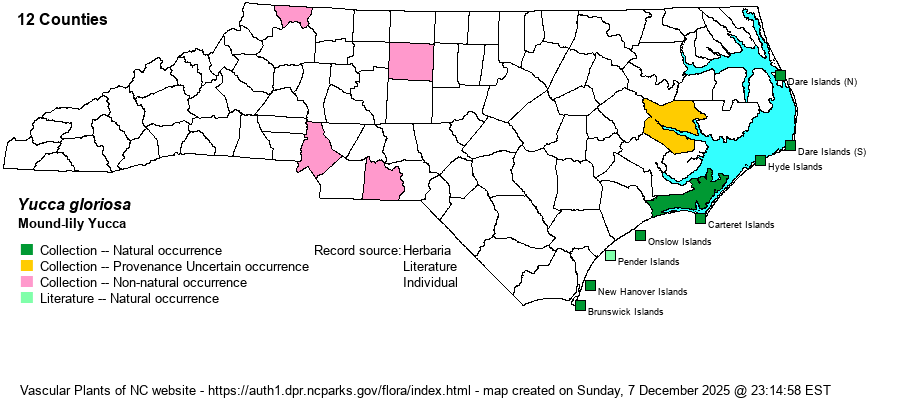| Author | L. | |
| Distribution | Native occurrences are believed to be strictly along the coast, from Dare County south to the SC state line. Records from farther inland certainly must relate to escapes or planted individuals.
This species occurs coastally from NC to northeastern FL, and then scattered westward from inland GA to LA. It is surprisingly scarce in FL, not being found south of the northern counties.
| |
| Abundance | Uncommon to infrequent along the coast, seemingly about as numerous in NC as is Y. aloifolia; both are restricted to dunes and sandy soils along the coast. As with the latter species, this species is likely planted in yards and other sandy ground along the coast and may escape (?) to dunes; thus, native populations may be difficult to discern from non-native ones. This is a State Significantly Rare species. Though it might not be any more rare than Y. aloifolia in NC, the latter species is ranked globally as G5, as opposed to G4?, and thus Y. gloriosa is a more limited species in range and numbers and thus more of conservation concern in NC than is Y. aloifolia. It has a State Rank of S2S3. | |
| Habitat | It occurs essentially only on dunes and in sandy soil immediately behind dunes. Habitats in NC appear to be the same as for Y. aloifolia. Though RAB (1968) states “Edges of brackish marshes and moist depressions in sand dunes”, implying that this is a wetland species, or at least is found in wetter soils than is Y. aloifolia, records in the NC NHP database seem to suggest this a dune or sandy soil species, without a particular affinity to moist soils. Certainly, it can occur in such damp soils, and thus more details about the specific micro-habitat preferences of these two species in NC are warranted. |
| Phenology | Blooms in fall, mainly in October; fruits in November and December. | |
| Identification | This evergreen woody species and Y. aloifolia are very similar in habitat and appearance. However, Mound-lily Yucca has a narrow, very smooth brown margin to all leaves; running a finger along the leaf edges does not cut the skin. Aloe Yucca, on the other hand, has a green leaf margin that is heavily adorned by tiny teeth – not easily seen from more than a foot away – that can cut the skin. In addition, the leaves of Mound-lily Yucca are somewhat more flexible and usually do not break or tear when strongly bent. To quickly separate these two, run a finger lightly along a leaf margin. Also, this species blooms in mid-fall, several months after Aloe Yucca, which bloom in June and July. Both have spectacular tall panicles of terminal, large white flowers than face downward. When you are driving or walking along the beach or along a beach road, and you see a yucca growing on a dune or near a dune, you are not likely to be able to make a correct identification, unless the species is in bloom; you will usually have to reach the yucca and conduct the “finger test”. Note that Common Yucca (Y. filamentosa) can at times occur around dunes, but its leaves have filamentous/shreddy margins. | |
| Taxonomic Comments | None
| |
| Other Common Name(s) | Spanish Bayonet, Spanish Dagger. Note that Yucca aloifolia and Y. gloriosa are both named as Spanish Bayonet or Spanish Dagger in some references, both being idiosyncratic names. The use of “Yucca” with a modifier name ends confusion, especially as “Aloe Yucca” clearly refers to Y. aloifolia. | |
| State Rank | S2S3 | |
| Global Rank | G4? | |
| State Status | SR-P | |
| US Status | | |
| USACE-agcp | FAC link |
| USACE-emp | FAC link |

